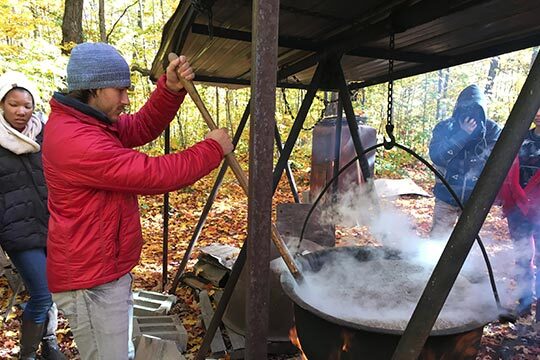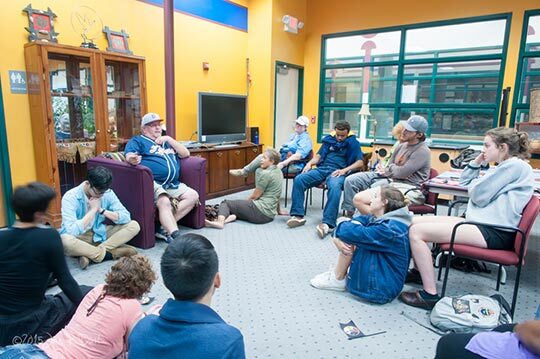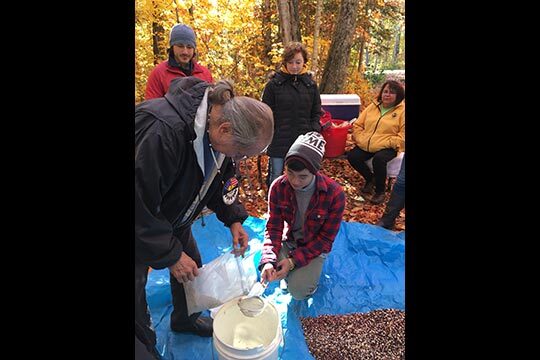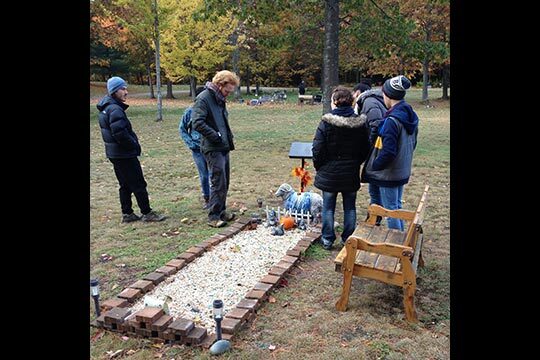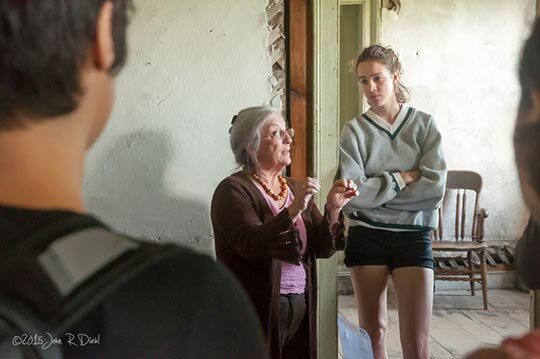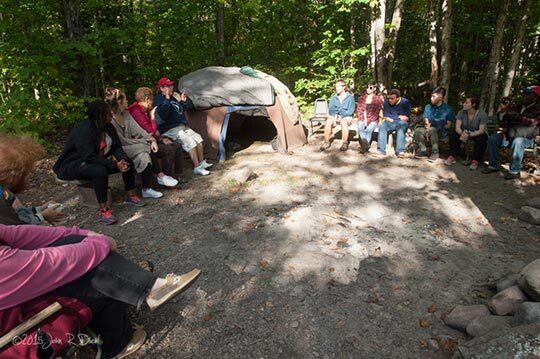A gathering of the tribes
Students enjoy somewhat unprecedented access to Sault Ste. Marie Chippewa Tribe rituals, customs, and celebrations in an immersive course that takes them to Michigan’s Upper Peninsula. Read the full story at Michigan’s World Class. Watch a video. (Text by Laurel Thomas-Gnagey.)
-
Stirring the pot
During a trip to the Upper Peninsula, Aaron Finglass, a student in the course “Archives and Oral Histories,” stirs a large cauldron used to boil a mixture of corn, ash, and water. At the onset of the course, Finglass and his classmates were asked to write an essay that answered the question, “What is an Indian?” Most admitted they were not sure. Some said the name invoked images from popular culture: cowboys and Indians, war paint and feathered headdresses, the natives in the story “Peter Pan,” and the controversial Pocahontas, portrayed in an animated movie released around the time they were born. Nearly all were sure they never had encountered an Indian in their lives. (Image: Dana Sitzler.)
-
Oral history
Through the “Archives and Oral Histories” course, U-M students met Cecil E. Pavlat, Sr., a Sault Ste. Marie Chippewa Tribe community member and retired leader, and other community members from the Upper Peninsula. They hoped that by giving students an inside look at Anishinaabe rituals, customs, and celebrations they would be able to more accurately answer the question: “What is an Indian?” Anishinaabe refers to the Ojibwe, Odawa, and Potawatomi people of Canada and the United States. (Image: John Diehl.)
-
Catch a fire
A spirit of thankfulness permeates most of the Anishinaabe sacred rituals. Here, students and faculty help tribal leaders build a fire that will heat rocks for a sweat lodge, which is a time for expressions of thanks and prayers for others. Each student chose a “grandfather” rock that would be heated by fire and then placed in a small pit in the center of the domed, canvas-covered lodge. Students also gathered the cedar leaves that would line their path into the lodge and cover the bare ground where they would sit. Each step to prepare, including the precise placement of the leaves, had traditional significance. Pictured: Cecil Pavlat, Anita Gonzalez, Robin Wilson, Hunter Zhao, and Chloe Gonzales (background). (Image: Dana Sitzler.)
-
Kernels of wisdom
Long a staple of the Native American diet, corn is considered one of the tribe’s sacred foods, along with strawberries and meat. Even today, members carry out the long process of drying the ears, removing kernels from the husk, boiling them with hardwood ash, removing the hulls, rinsing off the ash, and drying them again before making dishes like hominy corn soup. Here, students Samuel Hamashima, Jo Ellen Pellman, Gabrielle (Dani) Hayes, Zach Kollodziej, and Christa Shelmon learn the technique for removing dried corn from the cob. (Image: Dana Sitzler.)
-
Cornash
Hardwood ash is added to boiling corn to aid in removal of the husks. After the corn is cooked, the ash is rinsed off and then the kernels are left to dry. George Martin pours hardwood ash for student Hunter Zhao to take his turn at sifting. Looking on: Aaron Finglass, Paula Modafferi, and Jackie Minton. (Photo: Dana Sitzler.)
-
Eating clean
The histories of Native American tribes are rarely written down but are relayed orally from generation to generation. This includes tales about spiritual beings and the origins of some of the traditions, but also accounts of the everyday lives of people. “The Anishinaabe tend to share their personal stories and experiences, something we don’t see in academia,” says Dana Sitzler, associate director U-M’s Office of the Vice President for Government Relations, which helped initiate the course. “We sometimes forget that our personal stories are just as important as what we’re doing.” Here, students rinse ash from the boiled corn. (Image: Dana Sitzler.)
-
Grave sights
Even the gravesites at Mission Hill Cemetery showed the contrast between tradition and contemporary culture. One grave was encircled with some 70 small fieldstones with first names crudely written on them, relatives presumably. A few feet away was a memorial with athletic caps and other paraphernalia bearing logos from teams like the Detroit Lions, Tigers, and the Michigan Wolverines. True to the reverence for storytelling, each grave offered a hint of the person buried there: photos, toy trucks, porcelain eagles, lighthouses, stain-glass butterflies, and dream catchers, are just a few of the keepsakes. (Image: Laurel Thomas-Gnagey.)
-
Talk to me
Although the stories do get passed down through the generations one thing that has not always been shared is the native language, Anishinaabemowin. It slowly has been disappearing, due in large part to the forced boarding school experience where native people were punished for using it. This made today’s elders reluctant to teach it to their children, so it rarely is used by modern generations. Here, U-M student Mia Massimino listens as Karen Sabatine, Chippewa County Historic Society board member, presents a guided tour of historic homes in the area. (Image: John Diehl.)
-
Talking circle
The first part of the course immersed students in the culture of Native Americans, and the second part asked them to take what they learned from archives and ethnographic research and turn it into a performance piece. Near the close of the four-day immersion in the Upper Pensinsula, San Duanmu, professor of linguistics, offered an observation during a talking circle, a message that resonated with many of the students: “There are people who approach a different culture and say, ‘Look how different they are from us.’ Then there are people that enter a culture and say, ‘Oh, look how similar they are to us.’” (Image: John Diehl.)
-
Revisiting the question
At Bay Mills Community College, students learned about efforts to revive the Anishinaabemowin language that has been disappearing among current generations. And by the end of the weekend, they were better equipped to address the question: What is an Indian? A “living, breathing culture” whose members have “strong teaching and traditions but are open to change,” said one. Another learned to see that “every day is a gift.” Yet another was thankful the weekend had provided a comfortable space “not to know” and to learn to answer the question. (Image: Brenda Austin, photographer and reporter for the Tribal Newspaper.)

